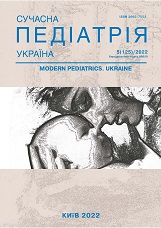Toxoplasmic chorioretinitis in the adolescent: description of the own clinical case
DOI:
https://doi.org/10.15574/SP.2022.125.117Keywords:
toxoplasma, adolescents, chorioretinitisAbstract
Toxoplasmosis is a zoonotic protozoal disease caused by the intracellular parasite Toxoplasma gondii and is characterized by a polymorphism of clinical symptoms with predominant involvement of the nervous, lymphatic systems, eyes, skeletal muscles and myocardium. Despite the variety of therapeutic agents, the treatment of toxoplasmosis remains problematic and requires an interdisciplinary approach. Complete the release of toxoplasmas from the body is difficult, although theoretically possible. This process depends on the combination of individual characteristics of local and general immunity of the macroorganism, the amount of the pathogen and its virulence.
Purpose - to present a clinical case of the patient with chorioretinitis as an example of a clinical manifestation of toxoplasmosis infection.
Clinical case. The girl turned to an ophthalmologist with complaints of worsening vision and red eyes. After a doctor’s examination, an ophthalmoscopy was performed, the presence of two chorioretinal foci in both eyes was confirmed. Examination for TORCH-infection is recommended. An elevated level of IgM and IgG to Toxoplasma gondii was detected. The patient received a course of antibacterial and hormonal therapy with a positive effect. After 8 months, the girl’s complaints resumed, signs of synovitis of the knee joints appeared, and anemic syndrome joined. During repeated ophthalmoscopy, three chorioretinal foci were found. The girl was hospitalized in the ophthalmology department for a more detailed examination and to decide on further observation tactics.
Conclusions. A case of chorioretinitis as a clinical manifestation of toxoplasmosis infection in adolescence is described. Timely diagnosis and started therapy of the above-described pathology are the key to a satisfactory prognosis for recovery, prevention of the development of negative consequences of this disease.
The research was carried out in accordance with the principles of the Helsinki Declaration. The informed consent of the patient was obtained for conducting the studies.
No conflict of interest was declared by the authors.
References
Bondarenko AN, Bondarenko AA. (2008). Diagnosis of toxoplasmosis in pregnant women. Modern infections. 4: 11-24.
Chene G, Thiebaut R. (2009). Options for clinical trials of pre and post-natal treatments for congenital toxoplasmosis. Mem. Inst. Oswaldo. Cruz. 104 (2): 299-304. https://doi.org/10.1590/S0074-02762009000200025; PMid:19430657
Dubynska GM, Izyumska OM, Kozyuk PM and others (2003). Toxoplasmosis. Clinic, diagnosis and treatment. News of medicine and pharmacy. 1 (129): 23-25.
Ermakova NA. (2012). Eye damage in toxoplasmosis. Ophthalmology. Practical medicine. 2: 51-56.
Estee Torok M, Fiona J. Cooke, Ed Moran. (2009). Infectious Diseases and Microbiology. New York: Oxford University Press: 894. https://doi.org/10.1093/med/9780198569251.001.0001
Giannoulis C, Zournatzi B, Giomisi A et al (2008). Toxoplasmosis during pregnancy: a case report and review of the literature. Hippokratia. 12 (3): 139-143.
Kramarev SO, Nadraga OB, Pypa LV and others (2010). Infectious diseases in children: a textbook. Kyiv: Medical University «Medicine»: 392.
Pappas G, Roussos N, Falagas ME. (2009). Toxoplasmosis snapshots: global status of toxoplasma gondii seroprevalence and implications for pregnancy and congenital toxoplasmosis. Int. J. Parasitol. 39 (12): 1385-1394. https://doi.org/10.1016/j.ijpara.2009.04.003; PMid:19433092
Popovich OO, Moroz LV, Chabanov FA. (2011). Toxoplasmosis (analysis of fundamental data). News of medicine and pharmacy. 5 (356): 4-8.
Sergiev VP, Lobzin YuV, Kozlov SS. (2008). Parasitic human diseases (protozooses and helminthiases): A guide for physicians. St. Petersburg: Foliant Publishing LLC. 592.
Vozianova ZHI. (2001). Infectious and parasitic diseases. K.: Health. 3: 266-294.
Yushchuk ND, Vengerov YuYa. (2009). Infectious diseases: national guidelines. Moscow: GEOTAR-Media: 1056.
Znamenskaya TK. (2008). TORCH-infections in obstetrics and neonatology. K.: Standard Digital Print: 200.
Downloads
Published
Issue
Section
License
Copyright (c) 2022 Modern pediatrics. Ukraine

This work is licensed under a Creative Commons Attribution-NonCommercial 4.0 International License.
The policy of the Journal “MODERN PEDIATRICS. UKRAINE” is compatible with the vast majority of funders' of open access and self-archiving policies. The journal provides immediate open access route being convinced that everyone – not only scientists - can benefit from research results, and publishes articles exclusively under open access distribution, with a Creative Commons Attribution-Noncommercial 4.0 international license (СС BY-NC).
Authors transfer the copyright to the Journal “MODERN PEDIATRICS. UKRAINE” when the manuscript is accepted for publication. Authors declare that this manuscript has not been published nor is under simultaneous consideration for publication elsewhere. After publication, the articles become freely available on-line to the public.
Readers have the right to use, distribute, and reproduce articles in any medium, provided the articles and the journal are properly cited.
The use of published materials for commercial purposes is strongly prohibited.

